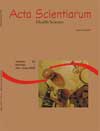Influência de vasoconstritores associados a anestésicos locais sobre a pressão arterial de ratos hipertensos e normotensos
Resumo
A utilização de anestésicos locais associados a vasoconstritores em pacientes hipertensos é controversa. Neste estudo, verificamos a influência desta associação sobre a pressão arterial caudal (PA) em ratos hipertensos DOCA-sal. Após ligeira anestesia com éter, os anestésicos GRUPO I - lidocaína 2% sem vasoconstritor, GRUPO II - lidocaína com fenilefrina, GRUPO III - lidocaína a 2% com noradrenalina, GRUPO IV - prilocaína 3% com felipressina, GRUPO V - mepivacaína 2% com adrenalina e GRUPO VI - mepivacaína com noradrenalina foram injetados na submucosa da boca (anestesia infiltrativa), em ratos DOCA-sal e controles. A PA foi determinada 5 e 15 minutos após a primeira dose do anestésico e também 5 e 15 minutos após a segunda dose. Os dados obtidos indicaram que: a) a PA dos ratos DOCA-sal (193,05 ± 4,25 mmHg; n = 43) foi significativamente superior àquela observada nos animais controles (115,64 ± 2,47 mmHg; n = 43) e, b) não houve variação significativa nas PA observadas em animais DOCA-sal e controles pela administração dos anestésicos locais testados. Assim, nossos dados experimentais sugerem que a presença de agentes vasoconstritores associados à lidocaína 2%, à prilocaína 3% e à mepivacaína 2% não interferem na PA desses animais, neste modelo experimental de hipertensão.Downloads
DECLARAÇÃO DE ORIGINALIDADE E DIREITOS AUTORAIS
Declaro que o presente artigo é original, não tendo sido submetido à publicação em qualquer outro periódico nacional ou internacional, quer seja em parte ou em sua totalidade.
Os direitos autorais pertencem exclusivamente aos autores. Os direitos de licenciamento utilizados pelo periódico é a licença Creative Commons Attribution 4.0 (CC BY 4.0): são permitidos o acompartilhamento (cópia e distribuição do material em qualqer meio ou formato) e adaptação (remix, transformação e criação de material a partir do conteúdo assim licenciado para quaisquer fins, inclusive comerciais.
Recomenda-se a leitura desse link para maiores informações sobre o tema: fornecimento de créditos e referências de forma correta, entre outros detalhes cruciais para uso adequado do material licenciado.























5.png)







